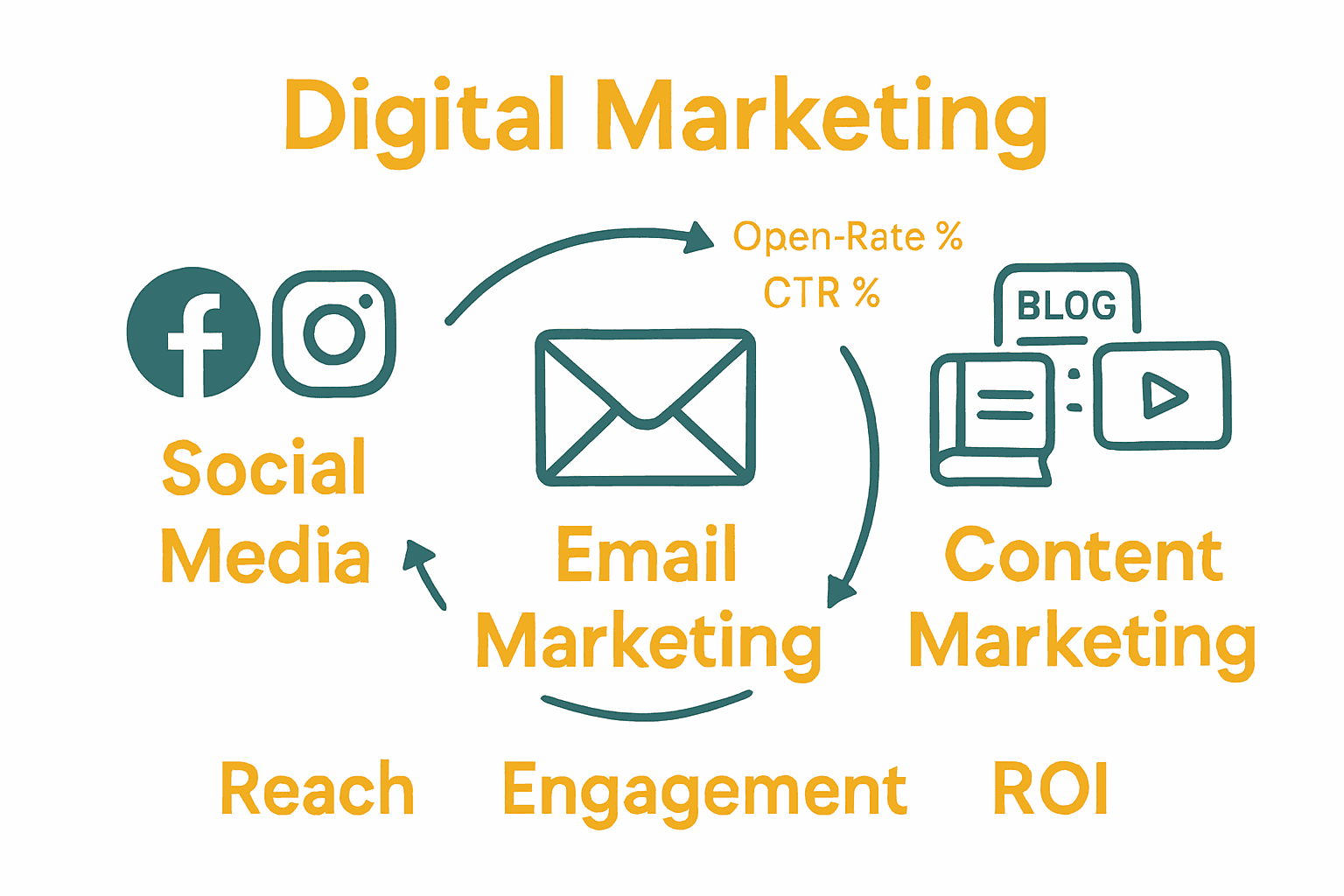Complete Guide to All Digital Marketing Channels
- Eddie The Chef

- Oct 21
- 7 min read

Did you know that Australians spend an average of six hours per day online engaging with businesses across multiple digital channels? Choosing the right mix of tools matters more than ever as every click, email, and post shapes how customers discover brands. By understanding the strengths and roles of each digital marketing channel, businesses can reach more people, increase engagement, and spark real growth in their market.
Key Takeaways
Point | Details |
Digital Marketing Channels Enhance ROI | Utilizing diverse digital channels enables businesses to improve direct communication and marketing effectiveness, ultimately enhancing return on investment. |
Strategic Channel Selection is Crucial | Regional businesses should focus on cost-effective digital marketing channels that align with their budget and audience engagement metrics. |
Integrated Approaches Yield Better Results | Combining different channels not only amplifies their reach but also enhances engagement through cross-platform promotion and unified messaging. |
Awareness of Risks is Essential | Businesses must be cognizant of potential pitfalls and financial risks associated with digital marketing strategies, implementing effective monitoring processes. |
Table of Contents
Defining Digital Marketing Channels
Digital marketing channels are sophisticated internet-based systems that help businesses communicate, promote, and deliver value directly to consumers. According to research from Understanding Digital Marketing: A Guide for Businesses, these channels enable two-way communication and significantly improve marketing return on investment (ROI).
In the Australian small business context, digital marketing channels encompass a diverse range of online platforms designed to reach and engage potential customers. These include strategic tools like Google Ads, Facebook Ads, blogging, location-based online listings, and email marketing. As noted by Queensland Government business resources, these channels support both organic and paid traffic strategies, allowing regional businesses to expand their digital presence effectively.
The key digital marketing channels typically fall into several core categories:- Search Engine Marketing (SEM): Paid advertising on search platforms- Social Media Marketing: Engagement through platforms like Facebook, Instagram, LinkedIn- Content Marketing: Blogs, videos, podcasts that provide value- Email Marketing: Targeted communication with subscribers- Affiliate Marketing: Partnerships that drive referral traffic
By understanding and leveraging these channels strategically, businesses can create comprehensive digital marketing approaches tailored to their specific audience and objectives.
For a deeper exploration of selecting the right digital marketing strategy, The Ultimate Guide to Digital Marketing: Choosing the Right Strategy for Your Business offers valuable insights for regional Australian enterprises.
Major Channel Types and Their Roles
Digital marketing channels serve diverse functions in helping businesses connect with their target audiences. According to research from Adobe Business, the essential channels range from social media marketing to email campaigns, each playing a unique role in building brand credibility and driving conversions.
In the Australian market, digital marketing channels typically encompass several key types. According to research from CML Labs, these include content marketing (consuming 21-30% of marketing budgets), which leverages visual content like videos, case studies, and ebooks; email marketing with impressive open rates above 20% and click-through rates around 3.1%; and emerging strategies like influencer marketing across platforms such as Instagram, TikTok, and YouTube.
The primary digital marketing channel types include:- Social Media Marketing: Organic and paid strategies for audience engagement- Email Marketing: Direct communication with targeted subscribers- Search Engine Optimization (SEO): Improving organic search visibility- Pay-Per-Click (PPC): Targeted paid search advertising- Content Marketing: Creating valuable, shareable information- Display/Video Advertising: Visual storytelling and brand awareness- Affiliate Marketing: Leveraging partnerships for referral traffic
Here’s a comparison of major digital marketing channels and their typical roles in the Australian market:
Channel Type | Primary Role | Key Benefit |
Social Media | Audience engagement | Broad reach and interaction |
Email Marketing | Direct subscriber communication | High open & click rates |
SEO | Organic search visibility | Sustainable long-term traffic |
PPC | Targeted paid search ads | Immediate visibility |
Content Marketing | Valuable, shareable info | Builds authority & trust |
Display/Video Ads | Visual storytelling | Brand awareness boost |
Affiliate Marketing | Partner-driven referrals | Performance-based growth |
By understanding the specific roles and strengths of each channel, regional Australian businesses can develop integrated marketing strategies that maximize reach, engagement, and ultimately, business growth. For more insights into crafting a comprehensive digital marketing approach, What is Digital Marketing? Understanding Its Importance provides an excellent foundational resource.

How Digital Marketing Channels Work Together
Digital marketing channels are not isolated strategies but interconnected ecosystems that amplify each other’s effectiveness. According to research from RB Australia, these channels create a synergistic approach where content marketing boosts SEO, social media shares expand content reach, and pay-per-click (PPC) advertising supports immediate visibility while organic search provides sustainable long-term traffic.
The integrated digital marketing approach is becoming increasingly sophisticated. Research from Monash University highlights emerging trends like conversational marketing, which combines chatbots and messaging apps with SEO strategies, and social commerce that leverages influencer marketing across multiple platforms. These integrated techniques create immersive, engaging customer experiences that transcend traditional marketing boundaries.
Key ways digital marketing channels work together include:- Content Creation: Develop content that can be repurposed across multiple channels- Cross-Platform Promotion: Share content across social media, email, and websites- Retargeting: Use PPC and social media ads to re-engage website visitors- Data Sharing: Use insights from one channel to inform strategies in another- Unified Messaging: Maintain consistent brand voice across all channels
By understanding how these channels complement each other, businesses can create a holistic digital marketing strategy that maximizes reach and engagement. For deeper insights into leveraging digital marketing for business growth, Understanding Why Use Digital Marketing for Business Growth offers valuable perspectives for regional Australian enterprises.
Choosing Channels for Regional Businesses
Regional Australian businesses face unique digital marketing challenges, including limited budgets, varied consumer behaviors, and complex digital expertise requirements. According to research from Small Biz Optimize, strategic approaches like local SEO and region-specific social media campaigns can dramatically improve visibility and engagement while keeping costs manageable.
Location-based marketing strategies have become increasingly critical for regional businesses seeking to connect with local customers. The Queensland Government’s business resources highlight innovative tools like geofencing, beaconing, and geoconquesting that allow businesses to send hyper-localized offers and leverage online profiles and reviews to attract nearby customers. These targeted approaches enable smaller enterprises to compete effectively in their specific regional markets.

Key considerations for channel selection include:- Budget Constraints: Focus on most cost-effective channels- Local Audience Targeting: Use geo-specific advertising options- Digital Skill Level: Choose platforms matching internal capabilities- Business Type: Select channels matching industry characteristics- Engagement Metrics: Prioritize channels with highest local interaction rates
By carefully selecting and integrating digital marketing channels that align with regional strengths and audience expectations, businesses can create powerful, cost-effective marketing strategies. For more comprehensive insights into regional marketing approaches, Marketing Australia: Complete Guide for Regional Businesses provides valuable strategic perspectives for local enterprises.
Risks, Costs, and Common Pitfalls
Digital marketing channels present complex financial and strategic challenges that can significantly impact business performance. According to Adobe Business research, channels like social media and pay-per-click (PPC) advertising require substantial creative investment and sophisticated tracking to effectively measure return on investment (ROI), making them potential financial risks for unprepared businesses.
Affiliate marketing introduces unique vulnerabilities that businesses must carefully navigate. Wikipedia’s digital marketing research highlights potential risks where affiliates might claim commissions without delivering substantive results, potentially exposing businesses to financial exploitation with limited legal recourse. These challenges underscore the importance of implementing robust monitoring and verification processes when engaging with digital marketing channels.
Key risks and potential pitfalls include:- Budget Overruns: Uncontrolled spending on digital advertising- Tracking Complexity: Difficulty measuring precise channel performance- Creative Fatigue: Maintaining engaging content across multiple platforms- Technical Limitations: Inadequate tracking and attribution systems- Compliance Risks: Navigating changing digital marketing regulations
By understanding these potential challenges, regional businesses can develop more strategic, risk-mitigated digital marketing approaches. For comprehensive guidance on managing these complexities, 7 Examples of Regional Branding Strategies for Success offers valuable insights into creating resilient marketing strategies.
Ready to Unleash Your Regional Business Potential?
Struggling to juggle multiple digital marketing channels while growing your local business? Many regional companies share the same worries—budget limitations, technical complexity, and the risk of wasting valuable resources online. The article unpacks how blending video marketing, web design, email campaigns, and social strategies gives you a fighting chance even in crowded markets. Yet, without a tailored plan and expert support, these strategies can feel overwhelming and leave your goals out of reach.

Let Marketing Recipes Australia take the pressure off by offering a personalised marketing plan built just for regional businesses who want simple, cost-effective digital results. Explore our full spectrum of services at Marketing Recipes Australia and see how a holistic ‘menu’ can help you choose the right mix of online channels for growth, engagement, and sustainable visibility. Don’t wait to outpace the competition—discover your complete marketing solution today and start building stronger customer connections across every channel.
Frequently Asked Questions
What are digital marketing channels?
Digital marketing channels are online platforms and strategies that businesses use to communicate, promote, and deliver value to consumers. They facilitate two-way communication and improve marketing ROI.
How do different digital marketing channels work together?
Digital marketing channels create a synergistic effect where, for example, content marketing boosts SEO, social media shares enhance content reach, and PPC advertising provides immediate visibility while organic search offers sustainable traffic.
What are the major types of digital marketing channels?
The major types of digital marketing channels include Social Media Marketing, Email Marketing, Search Engine Optimization (SEO), Pay-Per-Click (PPC), Content Marketing, Display/Video Advertising, and Affiliate Marketing, each serving unique functions.
What are common risks associated with digital marketing channels?
Common risks include budget overruns from uncontrolled spending, tracking complexities that hinder performance measurement, creative fatigue from maintaining quality content across multiple platforms, and compliance risks from evolving digital marketing regulations.
Recommended
Comments